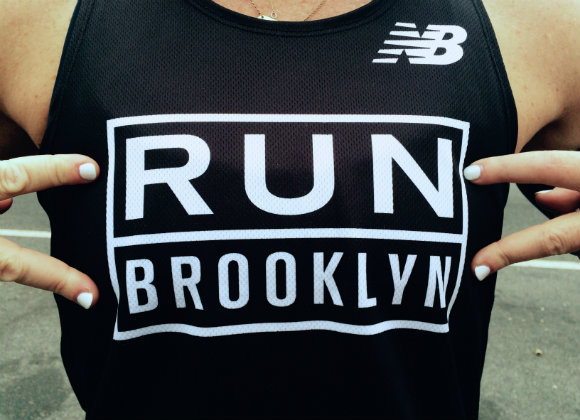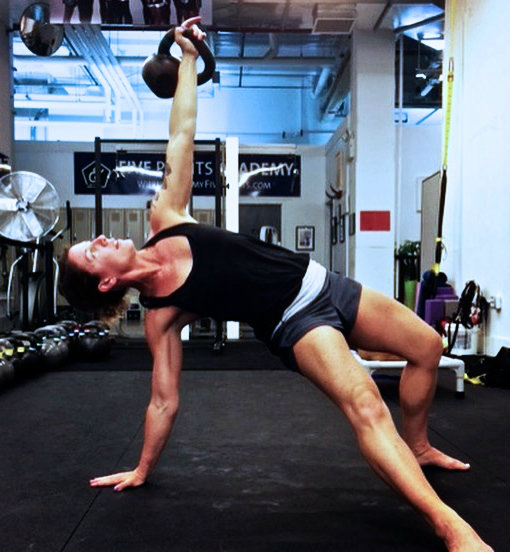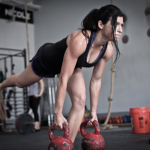I signed up for the Brooklyn Half Marathon this year with every intention of training for it with runs. Things don’t always work out they way you intend, though. But that’s where the great lessons are learned. Now, I have even greater respect for strength training.

Running History
I’ve been a runner for as long as I can remember, and competed in my first long-distance race at eleven years old. I preferred sprint distances and was on the indoor/outdoor track teams, competing at both state and regional levels.
Later, as a professional muay Thai fighter, I ran for conditioning: sprints once a week, with two or three distance sessions to build endurance. Now that I’m retired from fighting, I still run as a way to sort through life’s challenges and clear my head.
Running When I Was Fighting
As a professional fighter for fifteen years, I developed many compensation injuries and asymmetries. While rehabbing one of these injuries — a stress fracture in my thoracic spine (T1) that I was told would end my fighting career — I was introduced to kettlebells in 2008 by my trainer, Steve Milles (SFG II, SBS, CK-FMS, CICS). Not only did Steve get me back in the ring, but I went on to successfully defend my World Title.
Beginning the Half Marathon
The Brooklyn Half is a big party, and the race organizers do a great job of getting you pumped up. So when my friend Passa and I stood at the start line on a cold and drizzly May morning, I was pretty excited. Freezing, but excited. As the gun fired, we tried not to get too caught up in the excitement and to hold a sustainable pace.

Mental and Physical Challenges – and a Change in Plans
When I signed up to do the Brooklyn Half, my body felt great. But the moment I started training, my hip started giving me trouble. So I stopped running, but continued my strength training: a six-day-a-week barbell and kettlebell training program starting two months out from the Brooklyn Half. I never missed a workout.
Passa had followed a strict half marathon program along with our weight training, so I determined I would get to the park entrance with her, and then let her go. At mile three, we entered the park and I still felt pretty good. Not wanting to suffer the long, steep, s-o-b of a hill halfway through the park alone, I decided to stick with Passa a little longer, until we exited the park.
At this point, my right knee started giving me trouble. I tightened my abdominal wall to take the stress off of my legs. My lungs were on fire. Just then, we hit the hill and we hit it hard. I pumped my arms to carry my legs. I leaned forward, still standing tall to keep my lungs and diaphragm open. I pushed myself up that hill as the clouds opened up and started pouring rain on us. I don’t like running in the rain, but it cooled me down enough to relax and my lungs returned to their normal state. We made it off the hill and out of the park.
At the seven-mile mark, Passa turned to me and said, “You’re going to make it!” and I wondered, “Could I? But how? I haven’t run in months. How is this even happening right now?” Her encouragement gave me a boost, and I started thinking positively. My left glute ached, and there was a sharp pain in my right knee. I felt my left hip flexor carry the brunt of my torso. And even though I had only done a few two-mile runs, and by a few I mean three, and all indoors on a flat treadmill, I decided I could do this.
Because: Strength Training for a Half Marathon
This is what my training plan consisted of:
Monday/Thursday:
Zercher squat 5×3
Barbell deadlift 5×3
First set as a warm up. Sets 2 and 3 heavy loaded
Ab wheel
Tuesday/Friday:
Kettlebell Omelette
Double bells: 5 swings, 5 cleans, 5 presses, 5 squats, 5 snatches. One minute rest between sets. 5 sets. Done with 2 snatch test size bells
Hanging leg raises 5×2
Wednesday/Saturday:
Snatches and get-up (from the top of the snatch)
10 Snatches right arm get-down
10 Snatches left arm get-down
5 sets total each side not placing the bell down between sets
Sunday:
Rest
At mile seven, it dawned on me: my legs are strong enough — from the front squats and Zerchers — to carry me through the course.
I was introduced to Zercher squats at the SFL Certification with Dr. Mike Hartle and Pavel. They are now one of my favorite lifts. They work everything! Since the weight is loaded anteriorly, you’re forced to maintain a tall posture, hitting the abdominal wall hard as well as the back chain firing the lats and rear deltoids.
In addition to leg strength, my abdominal wall is strong enough to help me maintain proper running form, keeping me from slouching forward and collapsing down. This, in turn, removed weight from my hip flexors, so they could do what they’re meant to do, i.e., flex the leg to drive it forward.
Kettlebell omelets — just like the food — can be made from a variety of ingredients. My favorite combination is five movements that flow seamlessly from one to the next: swings, cleans, presses, squats, and snatches. These movements hit the anterior and posterior chains plus stimulate the cardiovascular system. I love doing this as an I-go-you-go training session, where partner A does all five moves, five reps each, without putting the bells down. Then the bells go down, and partner B’s go up. Five sets each partner. This omelet is a quick (about ten minutes), head-to toe-workout.
The other piece: kettlebell snatches. Because I used lower weight and higher reps, I conditioned my cardiovascular system, thereby increasing my lung capacity and endurance. The snatch is also a full-body movement that strengthens the anterior and posterior chains.
The Turkish get-up (TGU) is the knot that ties it all together. TGUs are great for upper- and lower-body stabilization. They link one half of the body to the other. This connection comes into play in running so that, for instance, moving the right arm pulls the left leg, and vice versa. TGUs also stimulate the visual system because you have to focus on the bell during the first few stages of the movement. For running, this helps me to keep a strong focus on the road ahead of me. (In other words, Turkish get-ups do it all!)

Back to the Half Marathon
Once I realized that I could finish the race, I turned on what I’ll call my “mental game.” I can do hard things. I’ve pushed through fights to come from behind and win. I’ve broken bones in early rounds, to finish the fight strong.
I’ve been strength training for years, and my legs are a lot stronger than I give them credit for. My arms and abs are strong enough to carry my legs. My core can keep my upper extremities in tune with my lower ones. And, by the end of that eight-week program, my lungs were conditioned to push through the hard parts.
The Finish
The last three miles are a blur. I knew I could trust Passa to keep us at a smooth and steady pace. It was like having the comfort of my trainer in the corner during a fight, knowing they had my back. For the first time in a long time (since my fighting days), I forced myself to let go and trust in Passa. The trainer became the trainee. I kept my form and focused on the road, putting one foot down in front of the other. As we neared the finish line, we pushed. We pumped our arms, and stretched our legs. We made it!
It wasn’t my intention to run the half marathon without training runs. But this experience proved to me how important strength training is. Whether it’s kettlebell, barbell, or bodyweight training, all athletes need a foundation. And, as Bill Bowerman says, “If you have a body, you’re an athlete.”





Not sure I fully follow the workouts. Double bells: 5 swings, 5 cleans, 5 presses, 5 squats, 5 snatches. One minute rest between sets. 5 sets. Done with 2 snatch test size bells. You mention double bell, but those are typically single bell movements except for the squats.
10 Snatches right arm get-down
10 Snatches left arm get-down
So, you are only doing the get down part of the TGU. I could see doing the get up portion, setting down the bell then doing the snatch. Any clarification would help. Thanks
Even marathon runners are finding strength training helps them.
You can only take aerobic fitness to a certain level. Past that, you need increased strength to be able to perform at a higher level.
Interesting article. i’m looking to experiment with running a half marathon with minimal running, but I can’t use your template because i train from home and what I have are adjustable dumbbells, one adjustable kettlebell, weighted vest, pull-up bar, dip station and rings. any suggestions? thanks.
Strength training has definitely helped me with either running faster or stronger. Primarily kettlebells and barbells. I recently have cut back on my running so I could focus on preparing for a Tactical Strength Challenge. However, today I ran a 15K race and I could tell the difference between this year and last year prior to really committing to strength training. Much stronger feeling when I finished and faster. The impact of deadlifts, squats and TGUs were apparent.
Thank you for sharing your story. I wish you to be and stay healthy to enjoy your passions.
However, I disagree with your conclusion that strength training enabled you to run a half-marathon. You write that you’re running since you were eleven. Given your picture that means about ten years of running. I believe this played the biggest role.
As someone who was never good at running anything above 100 m and always enjoyed lifting I cannot agree that strength training alone is sufficient to run. I can do a 5k without any running, but I mean it’s only 5k. In German it is called Volkslauf (“people’s run”), because anyone can do it. Don’t get me wrong. I still love lifting, but I think we should not overlook the elephant in the room.
Best of luck to you!
I also did a mini experiment to see if I could complete a half marathon with minimal run training and more focus on strength training. I have always considered myself a decent mid distance runner having running the 400m and 800m competitively in high school but always dreaded anything past 1500m. As I got older I have been focused more on strength training with barbells and I thought I’d challenge myself with a half marathon with training mainly focused on strength training. So I went about my regular strength training 3x a week and a month before the race, I started to run twice a week, one run ~5k and a second run ~10k. Come race day, I did the half marathon in 1hr56min, completing my goal of doing the half marathon within 2hrs which I considered quite a feat considering I was 78kg (172lbs) at 5’9″. Anyhow, it’s so interesting to see how much strength training contributes to running and I’m happy to see other people having similar results.
i, too, just ran a half marathon with hardly any running training. It started off to not be intentional but as it got closer and I just really couldn’t fit the running into my schedule for various reasons involving kids. I made sure to put my focus on strength training with primarily kettlebells, but also barbell and body weight. I also did sprints once a week. I was over my previous and only other half marathon time by about :30. It was really interesting to me to see just how much the carryover was.
Outstanding story. Very inspirational!
Excellent Emily!
Emily, I also practice Thai boxing, but of course nowhere near the level you do/did. As a (maybe retired) fighter, how did/do you integrate thai boxing and strength training into your programming?
I have found that strength training with kettlebells has enabled me to successfully take up short-distance (5k) running at 57 years old. My friends who have been running for much of their lives are very surprised.